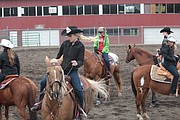Ready for royalty
Some of the horses did not want to cooperate in the wet and windy weather Sunday, but queens do not give up.
Miss Gem State Stampede and North Idaho Fair hosted the first "Rodeo Queen and Ambassador Camp" over the weekend at the Kootenai County Fairgrounds.
Hayle Carver, Miss Gem State Stampede director, said the purpose of the clinic is to prepare girls who are interested in being a rodeo queen or participate in a pageant. Some of the girls are already queens who wanted to learn all they could from the former royalty instructing the clinic, including Carver, Freya Ford, Alexcia Jordan and Kahla Noel.
Throughout the weekend, the clinicians went over everything the girls need to know about the process of becoming and being a rodeo queen.
"I think it is a great opportunity for any kids that are interested in it or rodeo queens that are doing it currently," said Cassy Ripatti, Miss North Idaho Fair and Rodeo Queen. "It just helps them to become a better queen or realize this is something they want to pursue."
Ripatti attended the event along with 15 other girls between the ages of 12 and 21, six of them title holders as rodeo royalty from around Idaho and the Northwest. Another group of 12 girls, ages 6-11, attended the clinic as well as a separate group. The older girls were split up into two groups by pageant experience.
Heather Skovgard, Miss Rodeo Idaho, traveled from Kuna to attend the clinic as a guest to help with instruction, as well as to bring awareness to the Miss Rodeo Idaho pageant. She said few girls from North Idaho have ever attended the state pageant.
Skovgard helped instruct the group of girls who had never won or never competed in a pageant. She said several moms had attended the clinic, which is important as well.
"A rodeo queen mom — there is a lot of jobs they handle that are outside of the queen's world that do need to be done," Skovgard said. "My mom does a lot of things that people don't always notice."
One rodeo mom, Cheri Thaut, came from Harrison with her daughter, 12-year-old Sarah, to attend the clinic. Sarah became the International Curly Horse Ambassador last April and her partner-in-crime is a chestnut curly named Twiz. Cheri said the clinic and the information they received was "awesome."
"They encompassed so much yesterday it was just unbelievable," Cheri said. "It is just how to present yourself when you are royalty. You are always representing, so you want to watch out for things like social media accounts."
Carver said on Saturday the clinicians had gone over much of the process of becoming a queen, starting with the application and interviewing processes. They also did some hair and makeup, modeling, speech and had a professional photographer take photos.
"These are all categories that are in pageants that they get judged on," Carver said. "Hair and makeup is part of the appearance."
On Sunday the girls saddled up and trained in the main arena at the fairgrounds, going over pattern breakdown, training techniques, flag runs, presentation runs and rodeo arena etiquette. Between outdoor training the girls would go back inside building 19 to discuss arena and parade preparation and assessing draw horses.
Ford and Noel gave the girls several tips about parades and arenas, such as laying their chaps over the horse to put on after mounting. Large flower bouquets are placed on the horses for parades, so it can be difficult to swing up without crushing them, Ford said.
Clean up after the horse, fix holes if they dig, and keep a checklist, because queens need a lot of gear, she said. Also, duct tape and double-sided tape has been extremely helpful over the years to hold sashes, or anything else, in place.
Draw horses are horses that are assigned at a rodeo, so the rider doesn't know the horse. Ford gave several tips for taking notes on all the draw horses ahead of time and work to the strength of the horse — if it stops well, use that to an advantage by stopping in front of the judges. She said safety is always the first priority when getting on a draw horse.
"As a judge, I wouldn't mark a girl down for trying to look out for her own personal safety," Ford said.
She said attitude can make a difference to the judges if they can see a rider is unhappy or angry about the horse they drew.
"The biggest thing is, the judges are not going to judge that horse," Ford said. "They are judging you and how you handle the situation."



